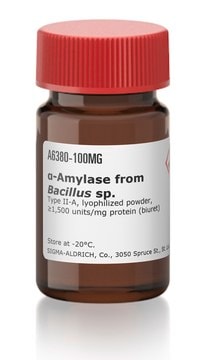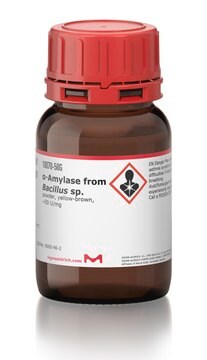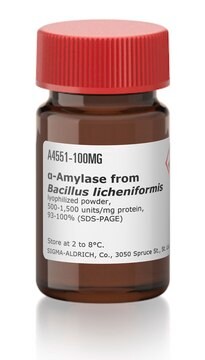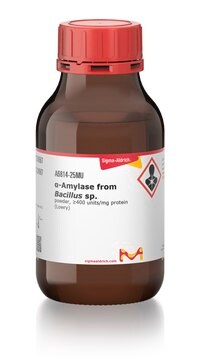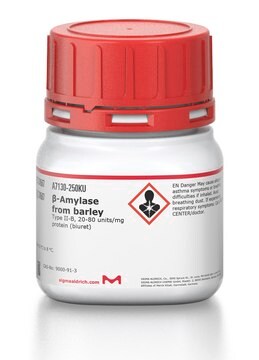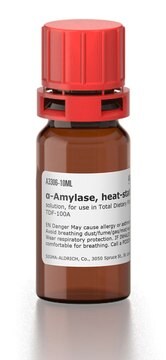10065
α-Amylase from Aspergillus oryzae
powder, ~30 U/mg
Synonyme(s) :
1,4-α-D-Glucane-glucanohydrolase
About This Item
Produits recommandés
Forme
powder
Niveau de qualité
Activité spécifique
~30 U/mg
Poids mol.
Mr ~51000
Température de stockage
2-8°C
Vous recherchez des produits similaires ? Visite Guide de comparaison des produits
Description générale
Application
- as a control enzyme in agar plate-based and carboxymethylcellulose-based clearing assays to screen cellulase activity
- for the hydrolysis of starch to explore the the role of wheat starch in frozen dough
- to inhibit Staphylococcus aureus biofilms
Actions biochimiques/physiologiques
Définition de l'unité
Autres remarques
Mention d'avertissement
Danger
Mentions de danger
Conseils de prudence
Classification des risques
Acute Tox. 4 Oral - Resp. Sens. 1
Code de la classe de stockage
11 - Combustible Solids
Classe de danger pour l'eau (WGK)
WGK 3
Point d'éclair (°F)
Not applicable
Point d'éclair (°C)
Not applicable
Équipement de protection individuelle
dust mask type N95 (US), Eyeshields, Faceshields, Gloves
Certificats d'analyse (COA)
Recherchez un Certificats d'analyse (COA) en saisissant le numéro de lot du produit. Les numéros de lot figurent sur l'étiquette du produit après les mots "Lot" ou "Batch".
Déjà en possession de ce produit ?
Retrouvez la documentation relative aux produits que vous avez récemment achetés dans la Bibliothèque de documents.
Les clients ont également consulté
Notre équipe de scientifiques dispose d'une expérience dans tous les secteurs de la recherche, notamment en sciences de la vie, science des matériaux, synthèse chimique, chromatographie, analyse et dans de nombreux autres domaines..
Contacter notre Service technique
